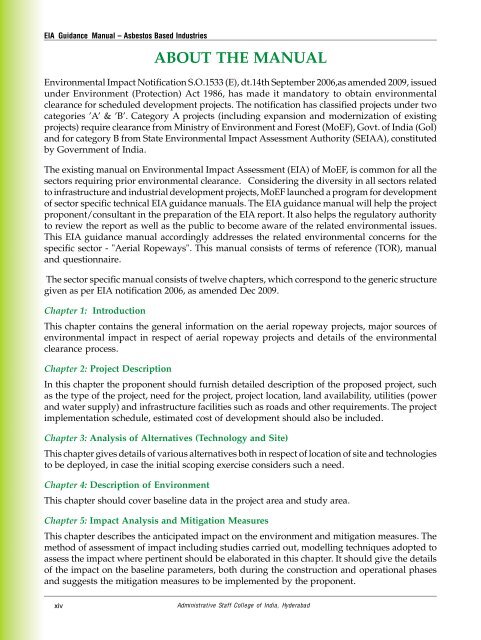Aerial Ropeways - Environmental Clearance
Aerial Ropeways - Environmental Clearance
Aerial Ropeways - Environmental Clearance
Create successful ePaper yourself
Turn your PDF publications into a flip-book with our unique Google optimized e-Paper software.
EIA Guidance Manual – Asbestos Based IndustriesABOUT THE MANUAL<strong>Environmental</strong> Impact Notification S.O.1533 (E), dt.14th September 2006,as amended 2009, issuedunder Environment (Protection) Act 1986, has made it mandatory to obtain environmentalclearance for scheduled development projects. The notification has classified projects under twocategories 'A' & 'B'. Category A projects (including expansion and modernization of existingprojects) require clearance from Ministry of Environment and Forest (MoEF), Govt. of India (GoI)and for category B from State <strong>Environmental</strong> Impact Assessment Authority (SEIAA), constitutedby Government of India.The existing manual on <strong>Environmental</strong> Impact Assessment (EIA) of MoEF, is common for all thesectors requiring prior environmental clearance. Considering the diversity in all sectors relatedto infrastructure and industrial development projects, MoEF launched a program for developmentof sector specific technical EIA guidance manuals. The EIA guidance manual will help the projectproponent/consultant in the preparation of the EIA report. It also helps the regulatory authorityto review the report as well as the public to become aware of the related environmental issues.This EIA guidance manual accordingly addresses the related environmental concerns for thespecific sector - "<strong>Aerial</strong> <strong>Ropeways</strong>". This manual consists of terms of reference (TOR), manualand questionnaire.The sector specific manual consists of twelve chapters, which correspond to the generic structuregiven as per EIA notification 2006, as amended Dec 2009.Chapter 1: IntroductionThis chapter contains the general information on the aerial ropeway projects, major sources ofenvironmental impact in respect of aerial ropeway projects and details of the environmentalclearance process.Chapter 2: Project DescriptionIn this chapter the proponent should furnish detailed description of the proposed project, suchas the type of the project, need for the project, project location, land availability, utilities (powerand water supply) and infrastructure facilities such as roads and other requirements. The projectimplementation schedule, estimated cost of development should also be included.Chapter 3: Analysis of Alternatives (Technology and Site)This chapter gives details of various alternatives both in respect of location of site and technologiesto be deployed, in case the initial scoping exercise considers such a need.Chapter 4: Description of EnvironmentThis chapter should cover baseline data in the project area and study area.Chapter 5: Impact Analysis and Mitigation MeasuresThis chapter describes the anticipated impact on the environment and mitigation measures. Themethod of assessment of impact including studies carried out, modelling techniques adopted toassess the impact where pertinent should be elaborated in this chapter. It should give the detailsof the impact on the baseline parameters, both during the construction and operational phasesand suggests the mitigation measures to be implemented by the proponent.xivAdministrative Staff College of India, Hyderabad
















